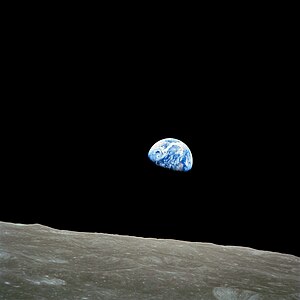Earthlight (Documentary)
| Earthlight Documentary | |
|---|---|
![]() Search Earthlight (Documentary) on Amazon.
Search Earthlight (Documentary) on Amazon.
Earthlight (Produced By The University of Arizona) is a documentary project and public outreach campaign that explores issues of food security and sustainability solutions. The project focuses on closed system bio regenerative life support technologies that are being developed by the University of Arizona with the support of NASA funding and expertise. A Bio regenerative life support system (BLSS) is a life support system concept that uses living plants to recycle astronaut's water, revitalize the air they breath, and provides food. Many mission planners believe that this capability is essential for long term missions on the surface of the Moon or Mars. The documentary also examines some of the spin off technological applications that may someday make cities in China and the Middle East more efficient and sustainable in a polluted and resource constrained future.
The title of the movie is the definition of light bouncing off the Earth toward the surface of the Moon. In the late 1960s, Apollo astronauts stood on the surface of the Moon and looked through this light to see Earth for the first time as a closed system. The famous photographs taken by the Apollo 8 team "Blue Marble" and "Earthrise," helped inspire the modern environment movement by shedding light on a concept that at the time hadn't received much thought.

The earth was finite. Now 45 years later the United States plans to return to the Moon. It is an effort both inspired by the desire to explore, but also by the challenge of understanding and copying the closed cycle systems inspired by the Earth. Lunar greenhouses will provide astronauts with a closed atmosphere so that they can live for long periods of time on the Moon. Scientist at NASA and the University of Arizona believe that these lunar green houses may also have an answer to the questions surrounding sustainability back home.
The documentary can be broken into five major parts. The issues of food security or examined first, than an earlier greenhouse design deployed in the harsh environments of Antarctica, then a explanation of how closed ecosystems function on Earth and in the greenhouse, followed by the robotic capabilities of the greenhouse unit and finally with an examination of how this technology may be used in cities of the future.
The educational documentary will be released on July 20, 2014 through NASA Television and will be streamed online through NASA TV website. The documentary features interviews with NASA scientists, U of A researchers and students exploring sustainable living and how projects like the lunar greenhouse can be connected to maintaining a habitable planet.
References[edit]
- http://ag.arizona.edu/lunargreenhouse/
- http://visibleearth.nasa.gov/view.php?id=57723
- http://cals.arizona.edu/earthlight/
- https://www.youtube.com/watch?list=PLXd4FtdxH3xpPEvzzZLFoyxQmK8xreluo&v=ipBq2Gpmhbo
- https://www.youtube.com/watch?v=bt0jTaH8afM&list=PLXd4FtdxH3xpPEvzzZLFoyxQmK8xreluo
- Dr. Gene Giacomelli - Principal Technical
- Investigator Dr. Roberto Furfaro
- Co-Investigator Phil Sadler
- Consultant Ray Wheeler is a plant physiologist at NASA's Kennedy Space Center
- Joel Cuello | Agricultural and Biosystems Engineering University of Arizona
This article "Earthlight (Documentary)" is from Wikipedia. The list of its authors can be seen in its historical. Articles copied from Draft Namespace on Wikipedia could be seen on the Draft Namespace of Wikipedia and not main one.
